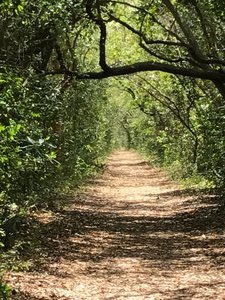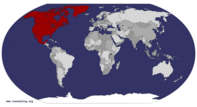Advertisement
Published: April 6th 2017

 IMG_0319
IMG_0319
The entry to Snake BightSnake Bight Trail, Everglades National Park, Florida
That's 'Bight', not 'Bite' - no-one got bit yesterday. In fact, much to Joan's disappointment, we didn't even see a snake. Although it wasn't for lack of trying!
Yesterday was a hiking day as we set out to see the sights of the southern part of the park. We started by going back to the visitor center, where we chatted up with another park volunteer, Roxanne, (who wants to subscribe to my blog and has friended Joan on Facebook. Its easy to become friends with park people, well, some of them anyway). Roxanne helps run the store part of the VC and we were in there to buy a long-sleeved shirt for myself, and Joan wanted another postcard for Annabelle.
At every National Park, I buy a tee shirt as a souvenir. In this case, though, it seemed a long sleeve shirt would be better, as long as it was light enough, to provide protection against the mosquitoes. We found one and it pretty much fit, so we bought it. We also managed to do a few things on the Internet, although I'm not having much luck uploading pictures. (We're going
outside the park today, so might find a better Wi-Fi connection.)
Wearing my new 'mosquito shirt', we headed out for a day of hiking the southern part of the park. First stop was Paurito Pond, supposedly a good spot for birding!. Now I am not a birder. Some birds are pretty to look at, and a few are interesting in various ways. But I really don't see any value in straining through a pair of binoculars at some birds nest a half-mile away, trying to determine if the wing is tipped with yellow or brown because you need to determine if it is a yellow-tipped warbling eastern thumbsucker, or just a regular sparrow! I simply can't get very excited about dinosaur descendants - I just don't get it.
So you can imagine my ire when, at the edge of this pond, I'm looking out at the expanse of water, bordered on all sides by vibrant green mangrove forests and a swarm/flock/gaggle (?) of bird watchers emerges from a newly arrived van/bus and proceed to invade my spot, all the while chattering endlessly with each other about some white dot on the other side. They seemed to like that

 IMG_0287
IMG_0287
Nine Mile Pondexact spot where I'm standing and proceed to establish their tripods and feet right next to and, sometimes, on top of mine! Needless to say, we left shortly later. If there were things to see there, they got sidelined by an aggressive herd of Homo sapiens horriblus.
Next stop fared better. We pulled off at West Lake with the promise of an short interpretive boardwalk hike that explained the mangrove hammocks. Joan befriended an old codger maintenance guy, and he explained all about the 'coots' on the lake and showed the alligator stalking them from behind. (Joan tends to get all of her information from people - and remembers it - while I like to read books. Between us, we make a good pair). It is also on a 'lake' of sorts which is really more of a secluded spot in the estuary, all part of the Florida Bay.
A Hammock is a spot of built up land, dominated by a forested area. Sometimes they refer to 'Tree islands' in the freshwater marshes, sloughs, as hammocks. But these islands dividing up the salt and brackish waters down here are all called hammocks. And, in this part of the

 IMG_0288
IMG_0288
There's Birds Out Therepark, these hammocks are made up of mangrove trees in the largest collection of mangrove forests in the continent. The 0.4 mile boardwalk trail at West Lake took us through the middle of one of the hammocks, coming out on the other side with spectacular and private views of West Lake itself.
Mangrove trees are simply remarkable creatures. There are several different species called mangroves, but here in Florida there are four basic kinds, red, black, white, and a tree called buttonwood. All of them, and all mangroves for that matter, have developed intricate mechanisms to deal with salt water and they are the only tree that can! The red mangrove develops these arching roots that stick out of the water, sucking in moisture from above the salt water, and elevating the entire tree above the normal high-tide line. Black mangrove trees push up pencil-like shoots up and out of the water so they can breathe above the salt water. Mangroves do a remarkable job of filtering salt out of the water, but they can't get it all. So at the end of every branch, they send the salt down to a 'sacrificial leaf', usually the oldest one on

 IMG_0292
IMG_0292
There's Onethe branch. That kills the leaf and turns it red. It then falls into the water and becomes the basis for the food chain that supports these areas, all the way up to the alligator top-dog.
In a forest of these trees, the result is a tangled web that is completely resistant to walking through, and hence the boardwalks, built above this tangle, to give us visitors a sense of what is in there. There is no doubt that a walk through a mangrove forest is an eery and unusual experience.
And that is exactly what we did on our last stop of the day - the Snake Bight Trail. Now, as explained before, a 'Bight' does not mean what it sounds like. A 'bight' is actually a sort of bubble on a bay. If you look at a map, there is the large Florida bay, and then there are smaller little 'bays' off of the bigger bay. Apparently sea-worthy people refer to those as 'bights'. So the Snake Bight Trail is just a hike out to Snake Bight on the Florida Bay. The hike is a 1.8 mile path, one way, through a mangrove forest, spilling out

 IMG_0295
IMG_0295
Boardwalk into West Lake Trailinto saltwater marshes and ending up on a boardwalk that skirts a small edge of the bight. Maybe there are snakes in there, we didn't see any either in the water, nor on the trail.
But we did see mosquitoes. Snake Bight Trail was one that both Roxanne and Rita said we should avoid because the mosquitoes were so bad. They said that some hikers had come running out of that trail just covered with the bugs. But we've been told of hikes to avoid before by park people only to find out later that they weren't that bad and we missed a good opportunity. So armed with my mosquito shirt, long pants, socks and shoes, and a can of Deep Woods Off, we entered the tunnel.
it became obvious why mosquitos liked this particular path - on the east side of the trail is a stagnant canal, brown with the tannins of the mangrove tree leaves. On the west side was a depression that was likely, during wetter times of the year, filled with water as well. Above us was a canopy of mangrove trees that, at times, was so dense that sunlight couldn't even pry open

 IMG_0297
IMG_0297
White Mangroves the leaves and branches.
After about a half-mile the path turned slightly and the opening behind us disappeared. It reminded me of the hallways that kept receding in Kubrick's The Shining. Had we just entered a trail from which we would never return? After about a mile, though, the dense canopy receded a bit, shifting to a mixed forest of hardwood and cypress, in addition to the mangrove. Spears of sunlight penetrated through, brightening the path and the mood. Our clothing and insecticide kept the mosquitoes at bay, although we had to refresh our shields a couple of times. We got bit, but it was nothing like the carnage we had been expecting.
We saw little signs of wildlife in there. We have to believe it would be a prime spot for alligators and other animals, but they were either not there, or were very still. In the darkness it would have been difficult to distinguish between a log and a still alligator. There were a few birds in the trees above, but we heard them more than saw them. And occasionally we'd hear a small slap in the stagnant water, but no obvious indication of what it
might have been.
At the end of the hike, the boardwalk on snake bight, there was a payoff of sorts. You emerge out of the trail onto a muddy marsh area, still wet from the last high tide. And then shuffle up the boardwalk for a view of the saltwater marsh as the tide is returning. The colors are different and the air is fresh, and you can hear the waves in the salt water beyond.
Eventually, though, you have to return and walk 1.8 miles back to the car in that tunnel through the jungle. When we got back to the car, we were tired and relieved. What a terrific hike. Just goes to prove that the park people aren't always right! (17.1.27)
Advertisement
Tot: 0.063s; Tpl: 0.013s; cc: 14; qc: 27; dbt: 0.0323s; 1; m:domysql w:travelblog (10.17.0.13); sld: 1;
; mem: 1.1mb






















